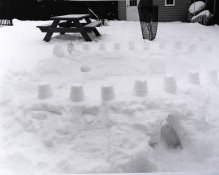Paul Ozzello
Member
You want to be nowhere near the shoulder.
Grain is created by increased exposure and increased development.
If youre seeing very low contrast and grain it means you are shooting on the shoulder where contrast drops off rapidly and grain increaes.
Its heavy overexposure ending up on shoulder thats causing the issues.
I wouldnt even be bothering messing around with films and developers when you can do all yr contrast adjustments in yr imaging software as long as yr image highlights are sitting on the straight portion of the film not the shoulder.
Just run a quick test overexposing a shot 0 +2 +4 +6 +8 and you should observe the same problem as overexposure increaes
I'm definitely overexposing, probably by a full stop maybe a little more. But I think for those specific flat snow scenes the x-tol (1:1) /delta combination is really exacerbating the problem : here is a comparison of Delta 100 processed in TMAX and XTOL, There's a huge difference in the highlight response, the tmax developer seems to give you much more latitude before getting into trouble. Yesterday I shot a whole roll of delta100 in the same lighting conditions and exposure and bracketed -1 -2 -3 -4 -5 to compare to the tmax film combinations. Anxious to see the results...








